‘ON GOD’: THE COMPLETION OF SOUNDCLOUD RAP, AND THE IRREVERSIBLE RISE OF OTHER MINOR MUSICS
'Drinking demon blood I can't even stand up.' Was 'SoundCloud rap music' a new music? And what happened to it? (--originally written in ~ 2019)
Drinking demon blood I can’t even stand up—Cnt Evn Stnd Up 222, Reptilian Club Boyz, 15 June, 2019
The Library of Babel but its a warehouse containing SoundCloud rap
anagrams for every combination of characteristics in the universe—DJ Kirsten Angel Dust, dms?, date unknown
I smoke sigils — st4cyghost, Instagram bio, archived 19 April 2020, now deleted
My serpents [?] (CA$HED COHBRUHZ production, lil’ ho)
Bitch, I’m a god, I’m a idol, angels close me (Eat my pussy)—Medusa Blood, Hi-C, 4 December, 2017
The music I was describing when I was describing Wagner’s music wasn’t the music Wagner made but the music I made when I heard it.—Nietzsche
. . . the instrumental interruption of telos by the universal (drum) machine . . . —Fred Moten
I can say NIGGA if I want to cuz i’m BLACK.—@imwoahvicky, 20 April, 2018
THE ORIGIN OF SOUNDCLOUD RAP
In a few decades, when more sober accounts of Donald Trump’s first term are written, perhaps music will play a role. To what extent was the Trumpian moment an occasion for musical innovation, for example in the area known as ‘rap’? More specifically, it might be said that ‘SoundCloud rap’ was an essentially Trumpian music, and could only have flourished under his controversial gaze. But why, and how, so? Was the Trumpocene really a form of remote control musico-political audition?
From at least the time of Trump’s inauguration, something happened not just to musicality but to how things were received more broadly — that is to say, acoustics. Trump’s arrival marked a unique movement of prohibition in the force fields of taking in. Some called this ‘resistance’ (#resistance), and justified it as such. Others called it ‘going deaf’: someone wanted someone not to hear.
From #notmypresident to #impeachbannon in early 2017, one tendency was to simply mute anyone displaying some form of ‘reactionary line’. Translated into musicology, if it was not your type of sound-content, demand for it to be removed from the provider. Later on, in Hulu’s four-part Hilary documentary, the same logic will be reported from Obama’s lips: ‘remember, this is no time to be a purist. You’ve got to keep a fascist out of the White House.’
Perhaps the broader choice to not listen and keep out was related to the political obstinacy of a non-interpretation (and by 2022 this impression has hardly vanished). If there was a decision at that time not-to — not to take in, not to listen — then it was at least made with a degree of self-consciousness. It was, let’s sound this out, a politico-supersonic strategy.
NOT LISTENING
This strategy is something like what Matt Taibbi and others have described in detail, how the Trumpocene occasioned calculated shifts and minimizations in fields of attention and listening. Not listening and not paying attention became justified tactics, even what Taibbi calls ‘rhetorical addictions’ to be paired with hate as a sort of machine. Civility was out, and doing everything to stymie the president was in. In Hate Inc. Taibbi wrote:
Before long it was a media trope that civility was actually a regressive thing, a balm to fascism. Incivility was a requirement, a show of solidarity.
And in his essay on the NYT’s changing editorial policy under Trump, the same problem is posed in terms of whether, given Trumpian conditions, ‘objectivity’ from the side of the reporter can justifiably be adhered to. Taibbi writes:
In the Trump era, even the Times has surrendered the hill, meaning the last connection to the objectivity era is gone. Goodbye to the white line in the middle of the road. We’re all driving blind now.
This driving blind is also a listening blind. A musical counterfactual comes into play: the election of Trump could have been a moment when objectivity was indeed rethought, but without the effect of losing ‘the white line in the middle of the road’. In reality that very moment of new conditionality — Trump’s first term — occasioned a principle of irreversible blanking instead. This moment or turn may be called ‘2017.1’ and, since we remain within it, even now, ‘2022.1’. Early ‘17 was a deaf spot of considerable duration and plangency. It affected whatever remains of music and whatever the music it happened to produce now becomes.
THE COMPLETION OF SOUNDCLOUD IDEALISM
Early 2017 was also a moment of completion—in the sense that in it political understanding as the means of listening effectively undercut its own conditions of survival. Completion, whether occlusive or otherwise, was as if automated by violently unexpected events. The well-known—and hackneyed—coupling of Brexit/Trump was one sign. Kantbot had already made the mock-troll claim in 2016 that Trump was a Kantian who completed the system of German Idealism, and the more evolved internet historian might now see that claim as serious. However one hears or refuses to hear Trump, his challenge to ‘the left’ was by 2020 felt as complete.
Political division was in that time thermally condensed, in the sense that the claim was made that the worst had happened, and any aspiring music of optimism would have to be let alone. Just as the Nazi theorist Paul de Man once said that ‘in the whole reception of Kant for three hundred years, nothing happened, only regression, nothing has happened at all’, so since 2017.1 nothing has happened, only regression, nothing has happened at all. Only 2017.1, .2, .3, and so on, has happened since early 2017, and if 2022 hits different, it is only because it is (almost) exactly the same.
But the exception here may have been music itself. By late 2020 and the time of ‘the Corona virus’ and the death of RBG, the conceptual lucidity of Mark Fisher’s capitalist realism and the musical conservatism that went along with it — Fisher’s tastes were, to be sure, somewhat retro—had been lacerated into what can now only be described as finalist conditions. Completion spreads all the way to species autocide, and to a sense of what Bernard Stiegler in his final book on Greta Thunberg called, without hesitation, the death of the universe. Greta was Stiegler’s Antigone of extinction metal. Sound became traumatic bliss, unlistenable.
The completion of times past, and the update into an absolute present, is expressed in what is therefore a touchstone of twenty first century conceptuality: SoundCloud rap music. SoundCloud rap, presented as the inner music of the Trumpian era, is still largely ‘unread’ beyond iterations of infamous deaths and consequences, from XXXTentacion to Lil Peep to Juice Wrld. What this music more truly reveals is the ontological timbre of the present (let’s say 2016 to 2020 at least) in all its figural lethality—but not just in terms of death’s personalism and negative glamour. ‘SoundCloud rap music’ presents all this with a completeness that still fails to belong to any other artistic or artificial plasticity of the present.
Sketched in early on in the Trump reign as merely the sellability of black death, SoundCloud rap became an immensely divergent and obscure set of sound disturbances, a bounty of sometimes lesser-known genres, running from Black Kray and Lil Mosey, the producer evilgiane and the work of babyxsosa, through Cargoboym and Matt OX, ssaliva and Sister Sosa, Bootychaaain and Lil Xan, Arnoldisdead and Bhad Bhabie, Dior5tar and digitalTREBLE, all the way to dead bart, slurrr, bod [包家巷], exxy44, sellasouls, monker178, avril23, crescent arc and USER-0. When the writer and musician Buum asserted a while back that ‘a strong case could be made that everything since XXXTentacion, Peep and 6ix9ine has been cope that is reacting to and trying to understand them’, it can be added that X, Peep and 6ix9ine may have been the progenitors of an egregious style, but they were hardly the entirety of their own musical set. Preceding Trump in the early days in Florida, then achronically spreading all the way from X’s assassination to the quattracento nugaze of Tennessee-based experimental collective Reptilian Club Boyz, SoundCloud rap went beyond generic diversity. It was a problem birthed, and transcendentally concluded, in 2017.1, in such a way that ‘2017.1’ became, like the transcendental deduction itself, a musico-political eternity.
‘WHAT IS SOUNDCLOUD RAP?’
We give some hints here as to why SoundCloud rap remains by definition not only unclassifiable but inaudible—and maybe even ‘mystical’. It is partly a question of coverage. In those years, it was the media that provided a racist matrix of listening: SoundCloud rap was only the music of young black death and young black misogyny. It was the music found (as collateral) in Tarpley Hitt’s Daily Beast hit pieces about X’s violent relationships and the moral relativity of Spaceghostpurrp, even though these takedowns were themselves ambiguous. But to cover it that way was to resist the music before it began, and to reduce it to a small number of artists who in truth fail to represent the vast domain of escape that ‘SoundCloud Rap’ continues to escape.
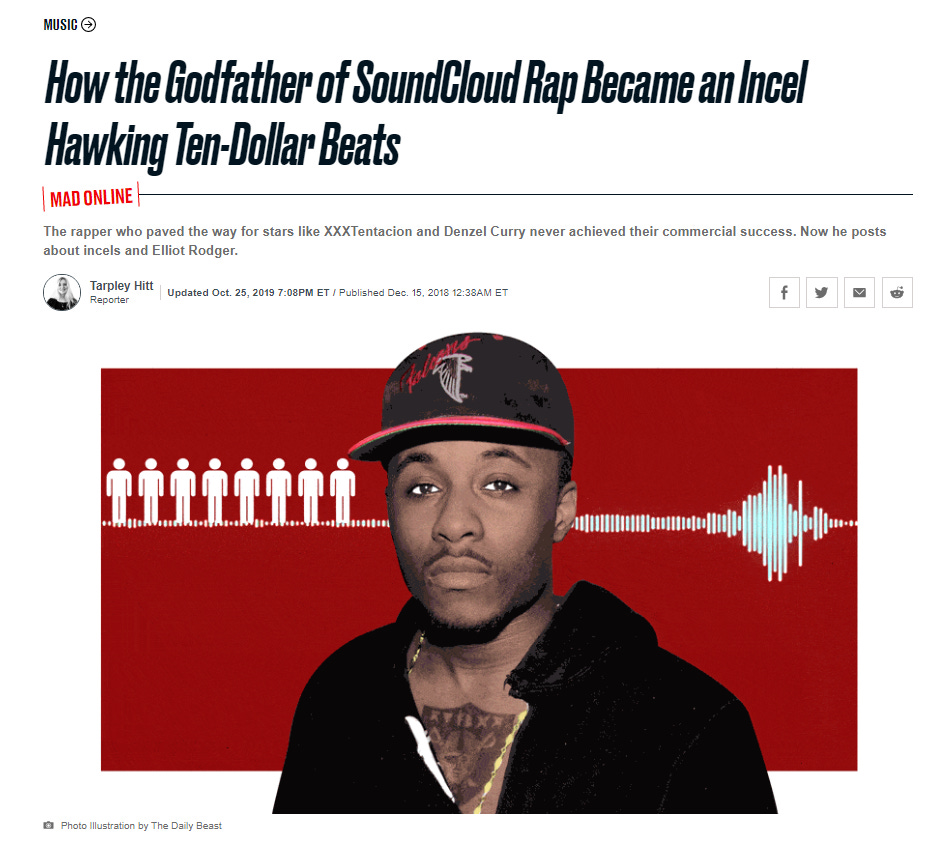
‘SoundCloud Rap’ is not or is not just a type of music and a mentality; rather, something else has happened under this generic set as a name {‘SoundCloud Rap’} that a kind of mystical mathematics is needed to think. We know from important work by Simone White in Dear Angel of Death that if modern rap presents an immense ‘moral’ challenge then it can’t be put to one side in any easy fashion. White says this already in the name of ‘trap’ and its distinction from other ‘rap’ musics, and this timelining and partition of hers (the dating of rap music into radically heterogeneous phases) brings with it its own problems. In brief, if ‘trap’ presents a kind of musico-ontological difference within the lineage of ‘rap’, what about ‘SoundCloud rap’? Was SoundCloud rap, especially and already ‘under Trump’, still ‘trap’ as such? Was ‘trap’ ever the music of Drumpf? Weren’t even black theorists behind the curve at that time and wasn’t ‘SoundCloud rap’—severely post-trap—rapidly becoming history?
THE MATHEMATICS OF ‘SOUNDCLOUD RAP’
Expressed pseudo-mathematically, the musics of examples like Lil Peep, Juice WRLD and XXXTentacion are only reducible to a subset in a larger, more mysteriously compact set, one that still needs to find its cardinality: all these deaths provide only one optic for a politico-musical genre that goes well beyond what has been discussed so far (with the exception of some of White’s writings), into what modern set theory calls ‘the absolute’, and which can’t simply be classified under the toplogical domain of the death drive and the divided diagrams of white and nonwhite subjectivity. There is no doubt that ‘SoundCloud rap’ matters; in fact, its mattering had to be taken towards more absolute matterings, towards more infinite ideas of how sound thinks.
Was this completion the musical absolute under Trump? In an anonymous essay by Alain Badiou, called ‘Towards a New Thinking of the Absolute’, the writer makes clear, following the work of Kenneth Kunen, that set theory’s openness to an endless series of newer infinities is able to reach, non-intuitively, a conclusion. There is in fact a Universe V of sets in which the total number of infinite sets finds its completion. Under a specific theorem provided by Kunen, Badiou is able to show in the third and final volume of Being and Event, also published ‘under Trump’, that there really is in the theory of infinities a limit. As he anonymously puts it, ‘there exists a point at which the process of reabsorption of successive infinities in an all-enveloping super-infinity has to come to an end’.
One might counterpoise to a potential experience of infinite completion in cloud music a capitalist realist, pre-Trumpian account of music. Contrary to Mark Fisher’s view that music was simply repeating itself (nothing great has been made for a while, and so on, he claimed), the experience one had of listening to SoundCloud rap was of being able to contain a set of infinities too great to ever catch up with — and which was therefore infinitely enjoyable—an experience which supplemented itself with a novel sense of absolute completion (the musicality of V). Novalis once wrote,
Is there a fine art of mathematics? Mystical mathematics. Musical mathematics. Has mathematics merely a finite purpose? Is it not purely theoretical? Truly pure mathematics?
The nigh-on mystical and mathematical experience that listening to what White names ‘the new music’ constitutes is a completion, the completion of SoundCloud Rap music Idealism.
SOUNDCLOUD RAP/TRAP/HEX
The thesis is that SoundCloud rap, the matrix of these latest developments, has turned out to be a Trumpian music in an anexact sense. That is, SoundCloud rap, and its sense of mathematical completion, lived, breathed and accelerated under the sigil ‘Trump’. One can extend this analogy even further and argue that just as it was only under background conditions of slavery in the Ducal court of Weimar that Bach was able to make glorious music, so it was only under Trump that Black Tray was able to make ‘Famous’ or that Lil Mosey ‘Noticed’ Fortnite Montages were able to appear. Quibble ahead, but it is to Donald Trump that we owe our thanks for the flourishing of SoundCloud Rap as a sign. SoundCloud rap’s acceleration — meta-acoustically— was only due to him.
An objection might be summarized in the words ‘historical coincidence’. Contemporary rap presents an imaginary Trumpocene parallelism. It happens to have happened under Trump, that’s all. But at the same time, what is ‘SoundCloud rap’, now, under Joe Biden? Anything? And what about Kanye West, who once ‘walked’ for president? What happened to the totally different set of sonico-topological conditions for ‘rap’ over time? What happened to ‘rap’ under end of time conditions?
‘SoundCloud rap’ is a conceptual breakthrough that is ongoing to an extent. Trump’s second term, after all, never depended on him starring in it. He was removed from the public square, which he now saturates off-site. Rap’s ongoing plasticity was expressed in Hamishi Farah’s 2014 film Marginal Aesthetics:
I think this is how rap can be so delicate. Rap music is fifty years ahead of contemporary art.
Rap’s delicacy might be imagined as its ability to increasingly replicate and replace thought itself—as if in the direction of the completion of a pure mathematics. Where words and even poetry fall to the ground, there was and is rap. And rap, or for example the phase of rap sometimes still called ‘mumble’, was no place for words at all. In fact, that part of ‘SoundCloud rap’ known as ‘mumble rap’ takes on complex meaning in a cultural moment when listening itself has been invalidated in political terms (the civility of attention may be withdrawn at will). The mumble of SoundCloud rap acts as a kind of mirror-image or reaction to these environments of audible blanking: if nothing now can be heard or received anyway, if everything must be robotically denied away, then music may respond in kind and will be, for the white listener at the end of time, unlistenable (you will not know what it says). The music the white listener listens to is a music meant only for the black listener, but the music knows this very fact, and has to open. All of that is available in sound, a sound which doesn’t know who listens. In truth, the mumble mumbles universally. That is to say, completely. As can be conceptually audited.
MUMBLE-INTERLUDE (SUMMARY): WHAT IS MUMBLE RAP?
For the reader/listener one hundred years later:
In completing German Idealism, as Kantbot seriously trolls, we may mathematically troll in reply and replay that SoundCloud Idealism is seriously completed as a set musically specific under Trump.
Trump is here an index and not a political after-party, the musical provocation of a tasteless mysticism. He was no less a musical fascism than the universal right to cull all conditions of organized life.
To the completion of Trumpian Idealism we therefore add the completion of SoundCloud Idealism. (Two sets, at least one repeat, no left or right.)
SoundCloud rap is not the music of young black death. If anything, it is the theory of the young extinct (the yung extinct girl: babyxsosa or Chief Keef’s sister, K.Y.O.T.G.).
SoundCloud rap is what Badiou would call V, the place within which all other arriving musics complete (given plenitudinous finitude of time).
SoundCloud rap is not Trap, even though it looks like it, and even though Trap is already a radical break with Rap.
There can only be a second term of Trump, beyond right and left politics, because in its completion SoundCloud Idealism will have been nonfinalist and additional (see below).
Roger Stone LITERALLY has a Richard Nixon tattoo on his back, and uses ‘Nixon’ as a verb according to Robert Mueller back in the day i.e. Roger Stone was the first SoundCloud rapper.
DJ Kirsten Angel Dust told me that uv ac changed the picture on SoundCloud for the song of the century.
Beauty and the Beta, and the rest of life as the pedo meme wars dropped, the title (‘SoundCloud Rap’) resonates as index, epochal representative, semiotic trash of millennia. Life over and under Trump and life under Chief Keef. Chic-nihilistic, robo-denialism, ‘weird’, ‘anti-PC’, mystical, like a Psycho-AI braindump. Commemorating ‘Dark Knight Dummo’ by Trippie Red or the way Lil Mosey’s voice over Fortnite montages is an arche-fossil. I don’t know what planet you’re on but I hope the apocalypse is the only thing that doesn’t come.
If ‘doubling down’ is the trope of the Trump era (‘doubling down’ for example in political opposition or willed denial), this denegatory trope also relates to conditions of accelerating extinction and not wanting to know. Denial has become automated, and it is not only that we don’t want to know, it is that the concept of extinction has failed to turn up, in part because of the pre-emptive force of this very denial. If SoundCloud rap had a unique maimed eloquence, perhaps it still finds itself located here—in a zone of inacoustics. It is as if, as with the originary political moment of the era (‘17), one were listening to a structural catachresis which almost falls within an auscultation—listening to something that can’t quite be heard. ‘SoundCloud rap’ would be the moment when extinction no longer having any coherence as a concept becomes true in sound (‘mumbling’).
White teaches us that trap is not quite or at all rap, and to this can be added that trap is not quite or at all SoundCloud rap and that SoundCloud rap is not and was not quite or at all surge and hex. These are important gradations to be listened out for, and then perhaps denied away in turn, since listening is always a form of muse, seduction and amnesia. These gradations are also gradations in the Concept as it attempts to cope with this music or is thrown off by it. If Farah was right that rap is fifty years ahead of contemporary art, then SoundCloud rap, which is perhaps decades ahead of trap and hip hop, was hundreds of years ahead of contemporary art, thought and writing. SoundCloud rap was not ‘black death’; it will have been precisely what delivers on other promises of completion.
In White’s Dear Angel of Death, an incredibly rich and detailed act of augmentation is managed so that the reader might glimpse almost all of what is said here, that ‘trap music’ is not just ahead of the game but captures the most serious stakes of contemporary atmospheres and vibes. Trap was not itself an illustration of this or that thought, it was ontological mood itself. Here is some of what White says:
What if this music, Future’s DS2, the Drake/Future What a Time to Be Alive, Vince Staples’ Summertime ‘06, Kanye West’s Life of Pablo, the numerous individual points that are sounds and words that emerge from laptops, artists who live within this surround, the formation that is trap music — more, there are more coming — speak the dimension, let us displace Heidegger and call it a metaphysical zone of intent, let’s call it ‘possibility’ — let’s call it now, cracked time of where we are and where we are going now. We don’t have the words for how broken. And yet we are warned.
‘The new universal is listening’, writes Moten in Black and Blur. But who and what is this listening? We say we and say yes, we are saying that such a new universal listening exists, and that it existed in SoundCloud rap as a sound domain or phonic cardinality. A domain of arriving noise. An infinity (interval) in listening. Anyone who listens obsessively to the variants of trap that have happened since 2016 knows this music has spoken where we are, just as White says, and, as can be heard when it comes to SoundCloud rap as distinct from trap and rap, is entering a panracial zone as (race-in-drag acoustics) universal listener, or at least a zone that is listened to by a new universal. And also that all this constitutes, as White says, a warning (‘and yet we are warned’).
Perhaps even, then, an increasingly severe warning. When White says, ‘there are more coming’, she must partly mean that the generic profusion of t(rap) as a music would continue, for example onwards to SoundCloud rap. Just as she notates in her book an essential series of shifts from Jazz and Blues to Hip Hop, and then on from there to Trap as itself an entirely other mode of intent, there might also be the beginnings of a description of a breaking out from within Trap of a first term called ‘SoundCloud rap’, and then, perhaps after it, many other important subgenres. More, there are more coming. There will be, listen or not, second terms.
LISTEN NOW POR FAVOR
If the reader is offered few immediate ‘examples’ of ‘SoundCloud rap’, it is because musicology’s reliance on the example can be reductive. As a matter of personal desire, everyone knows that sending a song to someone opens up a gap in experience, and may sometimes incurs more conditions of the unlistenable. Recall that quintessential Trumpian text, the ‘Exhibit # 30’ PDF of all phone texts between Michelle Carter and Conrad Roy. This putative ‘textual suicide case’ happened between January 2014 and September 2014, before Trump, but its consequences played out in the last few years, for example in a Hulu film from 2021 starring Elle Fanning. In one moment in the PDF, Carter gives the most precise expression imaginable of the use of musical examples to enforce love’s audibility: ‘okay. listen to our song. now por favor’, she says, again and again, until it’s time to turn on the ignition.
As a completion of its own music, SoundCloud rap occupies, as Trump will have done, all of its second terms. It is, as it were, example-averse, since it accumulates and stacks itself into a series of completed infinities—such is the ontics of listening to its CloudOlogy, the topological plateau of completion and not morbid Fisherian recursivity (‘here is my playlist, please remember me by it’). One of the musics which seemingly came after ‘SoundCloud rap’ — there are many arriving all the time, as White says— was ‘hex’ or ‘surge’. #REALHEX is often almost entirely anonymous and effaced in terms of where it comes from, and is, as music, not just an issue or a question (yet another subgenre) that can be answered and described in a simple way—despite certain definite effects of its own and of rap’s antecedent completion. How it names itself, whether and if it can distinguish itself from nightcore for example and even from ‘s/cloud rap’ itself: this is how ‘hex’ can be heard, what it asks of itself, what it makes possible as doubling, and doubling even of completion.
It is White’s Dear Angel that also displays a praxis of music lists, the question of the favorite or at least the litany of sonic historical moments, to which we add our filter at the end. For White this listing as writing (no doubt there is some universal listing) will include the ongoing question of the ‘new music’, and a risked stretching of Moten’s work and what made it possible (DuBois, Baraka, Mackey, and so on). In fact, just as Moten omits to write about ‘trap’ in writing only about ‘jazz’ and ‘hip hop’, White may be said to twist up and away from writing about ‘SoundCloud rap’, even though she ends her book with X in the ‘sources’—is her Angel pointing there? Is there now a Dear Angel of Extinction? For the moment we can speed-formalize like this:

IRREVERSIBLE ENLIGHTENMENT AS SURGE MUSIC (HYPER HEX, HYPER SURGE)
On March 30, 2020, on Twitter, Yangqi Zheng, the teenage Daoist mob boss visionary alchemist, noted that the main concept of thermodynamics is irreversibility, and went on to mention a ‘thermodynamics of information’, asking whether, in effect, something like a certainty of enlightenment might be possible. Another way of putting this, he said, would be to ask whether an irreversibility of enlightenment is possible. Or even a surge.


The idea of an irreversibility opposite to the one we are used to in the second law of thermodynamics might in fact have been already found, in the atmosphere of 2020, in the music of ‘hex’ and ‘surge’ . In an archival mixtape on the ‘dismiss yourself’ YouTube account, the curator notes that ‘Surge/Hex is a genre in its infancy, with roots in nightcore, trap, florida speed and the underground internet rap scene.’ This style was also called ‘tread’ at the time, and it comes, as if a second mathematical term, and as if in anticipation of a ongoing second ‘Trumpian’ term (which is to say an absence in his name). Hexcore is, if you like, the signature sound of SoundCloud rap’s completion—and, perhaps like the entropy inversion algorithm in Tenet (Nolan, 2020), it is also what set theory calls ‘resurrection’ in the absolute of the V.
It is here that the comparison with Fisher can be sharpened. It has become a commonplace to write of artistic mourning, to say, for example, that music mourns this or that idea or chronology. Would he have been able to listen to it, we can imagine Mark Fisher making this claim about ‘hex’, under the now overused rubric of ‘hauntology’. But, crucially, hex’, insofar as it existed at all as a genre, seemed to have little to do with spectres of pathological grievance and originally Derridean posthumous meaning architectures that radical music analysis likes to evoke. Hex was, in a quite precise way, purely additional. What it repeats is already complete — ‘SoundCloud rap’.
CHANT, KOAN, MOAN, SPRECHGESANG, MUMBLE, HEX
Dear Angel of Death takes 150 pages to carefully locate trap, so this essay will have been only a hint as to what the musics of SoundCloud rap are, a small attempt to hex and give s/o to the pure math of Simone White. Just as Mondrian’s Broadway Boogie Woogie can never be saturated by the label ‘Neoplasticism’, so ‘Dawsru X Dior5tar AngelcoreShawty444 HEXD MIXX’ can only ever be constrained by the term ‘hex’. A brief descriptive flash of what this new music was, and what its arising — its surging — meant, will be at best a cryptic engagement. Think to begin with of what Fred Moten calls in The Universal Machine ‘chant and kōan and moan and Sprechgesang, and babble and gobbledygook’. Such words go some way, in their litany-sound and resistance, towards what is meant when ‘hex’ is said and heard. There is something of the mumbled complaint in this music, of the complaint as a rolling, fuzzing and fuzzy business that captures more time than it takes, gives time that is ending in ways that can’t quite be given, a sense of continuous acceleration, rotation, compression and simulated transformation. It is even as if complaint, having nothing to do with content or negativity, were the domain of the absolute mathematical mystic and analyst, a mystic-analyst who might now be imagined to have a sense of the irreversible as positive—and so of no ramped-up complaint at all. The poet Elaine Kahn writes, ‘my claim is on the absolute’. With a degree of shock, perhaps, the same absolute surge-claim is made by this juncture-music of ‘hex’/’SoundCloud rap’, for instance in this fugue, ‘AngelcoreShawty444 HEXD MIXX’. The surge that happens in this music is the surge of an irreversible dematerialization of whatever highs and lows even the intricate music of ‘trap’ (defined by White in amazing ways) was in the process of getting used to.
Can we give further examples after all then? No, but let us give them anyway.
‘Tomoe_✧theundy1ng - Rare RCB hexD.mp3’ was one of the many Mona Lisas of the Tennessee/Floridian school of hex music. It came from just before Coronavirus but the rcbs (Reptilian Club Boyz), as relayed by Cargoboym (Tomoe__✧theundy1ng) from Florida, were already using (angelicism) bat imagery when it was released, as seen on the cover. It’s here, in the middle part of the sequence, that the words can be heard, ‘drinking demon blood / I can’t even stand up’. In other words, in this example-couplet hex is a deep world ADRENOCHROME high ferritin/iron levels type of music, purely mythical, and machinic beyond the lean and molly that defined late Trap’s narcosis. Besides, it’s been confirmed a rumour that all the rcbs are Trump voters and read Nick Land.
A first definition of ‘hex’ is given here in the complete loss of original. Hex is not merely nightcore because nightcore is a 1-setting speed variation, and the original is usually nominated. A hex, on the other hand, tends to cut all ties with any original, or the song is created already in a state of hex, but the hex is still subject to variable speeds. Hexes of a song may appear over a year or so and then eventually ‘the original’ is dropped, as happened with Dior5tar’s ‘Hex4yu’. In many cases, hexes are hardly nominated at all. The hashtags given may be #truehex or #truhex or even #hyperhex, but the musical moments are not really formalized as a genre, and maybe never will be. From their Instagram account comments, one observes the musicians prefer to be invisible. Invisible becomes a form of deepworld klout. Under end of the universe conditions, way beyond the preparatory ironies of capitalist realism, musical careerism makes no sense at all.
In her 2017 text ‘Nightcore and the Virtues of Virtuality’, Emma Winston says that nightcore is distinct from Fisher-era hauntological descriptions of music, writing that ‘nightcore seems almost uncritically accelerationist, both temporally and ideologically, in comparison’. However, if one can distinguish nightcore as a form of musical u/acc from Fisher-era musical hauntology, then hex triply dematerializes what nightcore is still haunted by (that is, an original). Hex, if there is some, galvanizes Nightcore and even the memory of AIDS-3D as conceptual breakthroughs but bases them in an organic use of super-intelligence in sound, also connecting this further dematerization to pure translation, namely, to one with no original at all. Perhaps the only person to describe hex before its time was Paul de Man in the posthumous notes for his lecture on Benjamin’s essay on translation, in which he says that ‘the translators are beyond the poets’, and that true translations are more ‘ultimate’ than the original, like Hölderlin’s Sophocles. Abstract Hexing doesn’t need and doesn’t want an original; it is only additional. And nobody will describe hex because it isn’t an answer, it isn’t a sound . . . it is the squeezing that interrupts the coherence of world thought as eidetics reduced to Universal Probability = us. The purely mathematical notion must remain unheard-of.
MUSICAL ANGELICISM
Listening to the thing that allows you to listen to whatever SoundCloud rap and hex are ends up messing with whatever makes possible any sense of the audible you have and this takes things into a zone of angelicism. Musicological angelicism can be located either explicitly or subatomically (beyond the track). Scanning back to October 2020, Black Kray has just released ‘4 TRUE “ THUG ANGEL ”’, produced as ever at that time by evilgiane, whose signature sound had a kind of angelico-geometric precision to it (the tick tock of exactitude that isn’t just human). Where Metro Boomin signed something like the Trump Transition moment, evilgiane formalized something like the problem of the second term that never quite came. In Lacan’s late Seminar XXIV, L’insu que sait (the non-known that knows), he evokes ‘the geometry of angels, namely, something which despite writing does not exist’. He goes on to say that ‘geometry explicitly concerns the angels’. Since evilgiane’s sound is and was geometric, we can say it concerns the angels too, both explicitly and implicitly.
That track occurs somewhere next to—in the same set universe as—digitalTreble’s ‘%HExD_ANGEL$666 W/DIOR5TAR’. Both annotate a logically and logistically angelicist grasp of music making use of completion. The script (vocals) in either track is reduced to something that leaves ‘mumble’ behind, acting like an AGI abbreviation of what Finnegans Wake did—in this hexed angelese you can hear not just all languages or babble, or whatever, but new languages, languages we don’t know exist yet (hear: angelicism). In fact when it comes to great works of the past, from Phaedo, Discourse on Method, Hegel’s Logic, John’s Apocalypse, Mallarme’s Un coup de dés, and then Chief Keef’s Thot Breaker in early 2017 and White’s Angel the year after, we can now add without doubt these masterpieces of sigils and ‘language’ like ‘AngelcoreShawty444 HEXD MIXX’ and ‘DIGITALTREBLE X MAGICSPELL-RAREHEXCOREM1X2020’. Musical annotation here keeps up with what can’t be kept up with. What gets marked is the transition from capitalist realism to something like an end of the universe realism (which Stiegler indexes with Greta Thunberg), and, after that, to a nonfinalist additional realism (hexing). This is where finalism (Fisher’s melancholia and nightcore’s simple speed change) comes into its own and is liquidated as what 2020 through 2022 has been calling, as a kind of joke, ‘angel numbers’.
Sent by sound in search of what can’t be sound, or of what is finer than the musical concepts carrying it, like Nietzsche making his own music of Wagnerism, the concept ‘extinction’ no longer makes sense from the point of view of this angelicism music, ‘SoundCloud rap’ taking as its second term (of additional musicological completion and realism) an angelical hexing. Since capitalist realism is up (over and completed, and passed over, and out), ‘SoundCloud idealism’ completes in our place, just as Kantbot said German Idealism will have done in Trump’s place, a messenger (to take a word from Dear Angel) for the pure math of Novalis. Since there is no time, there is time for this music, and since there is math in it, we can be sure of it (certain life).
Dialectically and mathematically, Trump’s first term meant formally to have survived Trump’s first term—which will have been the test of absolute nihilism—and then to only have repletion left. It meant to have been in this place. Black theory was hot then, too, at the start of Trump’s first term, but then passes itself over (passes over itself), and any other theorem will now do the same. Where White’s writing can’t now not point to is this pan-racial, additional music, beyond as it pretends the reduction of history to race war and blacked typologies (‘White’ in a noncoded sense). This music breaks down the distinction of extinction, that is, the distinction between this extinction (the one Trump one fine day in vanishing history called a Chinese hoax) and that extinction (the one that disappears into repetition and joy in music and only in musics arriving). The iterate-song of a minor hex, which was never just nightcore or pop or (t)rap, marked extinction’s inner resources of iteration, which is what made it all angelicist and a form of writing, not needing to be written down, something which despite writing does not exist, not needing to be heard.
‘READING’ LIST (SELECTION)
1.
Bootychaaain x Sickboyrari – Slayin’ prod. evilgiane & 4EVGONE
Dawsru x Dior5tar – ‘AngelcoreShawty444 HEXD MIXX’
Babyxsosa – ‘Enemies’ prod. evilgiane & Harrison
Tomoe_✧theundy1ng – ‘Rare RCB hexD.mp3’
Bootychaaain – ‘Me Now’ prod. SlurRty
K.Y.O.T.G – ‘Bag’ prod. Chief Keef
Lil Mosey – ‘Noticed’
digitalTreble – ‘%HExD_ANGEL$666 W/DIOR5TAR’
ssaliva – ‘close2me ss stretchd_ascent edit’
Dior5tar – ‘Hex4yu’
Dior5tar – ‘Stellar’
Dior5tar – ‘Robins Jeans’
Black Kray – ‘4 TRUE “ THUG ANGEL ”’, prod. evilgiane
Babyxsosa x Ppgcasper – ‘24hrs’ prod. evilgiane
Yungster jack x David Shawty x Baabyjane – ‘Untitled’ [leak]
Angel – ‘Yeah Right’ prod. srdbeatz & Bloom
2.
Simone White, Dear Angel of Death (Ugly Duckling Presse, 2018).
Jesse McCarthy, ‘Notes on Trap’, n+1, issue 32, Fall 2018.
Tarpley Hitt, ‘How the Godfather of SoundCloud Rap Became an Incel Hawking Ten-Dollar Beats’, Daily Beast, 15 December, 2018.
Tarpley Hitt, ‘The Inside Story of Jocelyn Flores, the Tragic Teen Who Inspired XXXTentacion’s Hit’, Daily Beast, 8 September, 2018.
Tarpley Hitt, ‘The Real Story of South Florida Rapper XXXTentacion’, Miami New Times, 5 June, 2018.
Jon Caramanica, ‘Juice WRLD and the Tragic End of the SoundCloud Rap Era’, The New York Times, 9 December, 2019.
Jon Caramanica, ‘The Rowdy World of Rap’s New Underground’, The New York Times, June 22, 2017.
Alexis Petridis, ‘Death, Drugs and Destruction: the Troubled Years of SoundCloud Rap’, The Guardian, 20 December, 2018.
Emma Winston, ‘Nightcore and the Virtues of Virtuality’, Brief Encounters, 1(1), 2017.




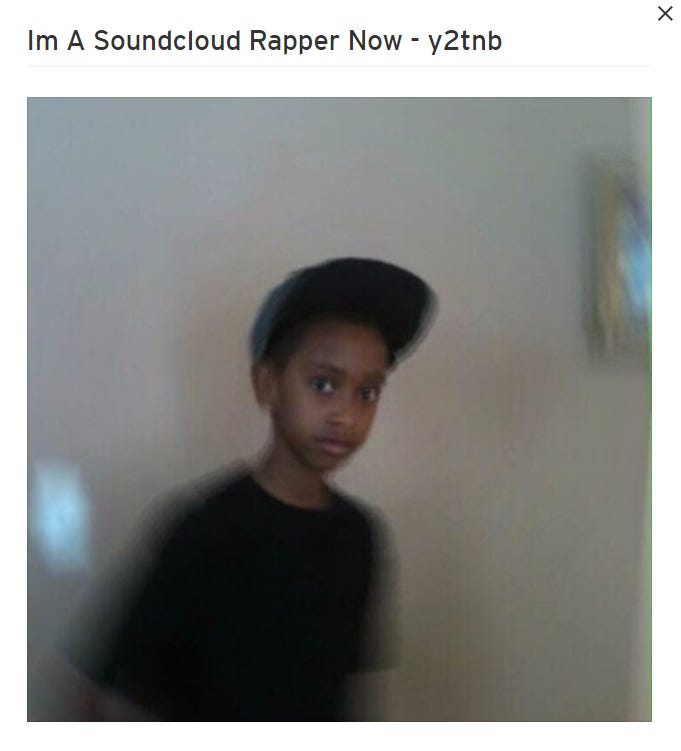




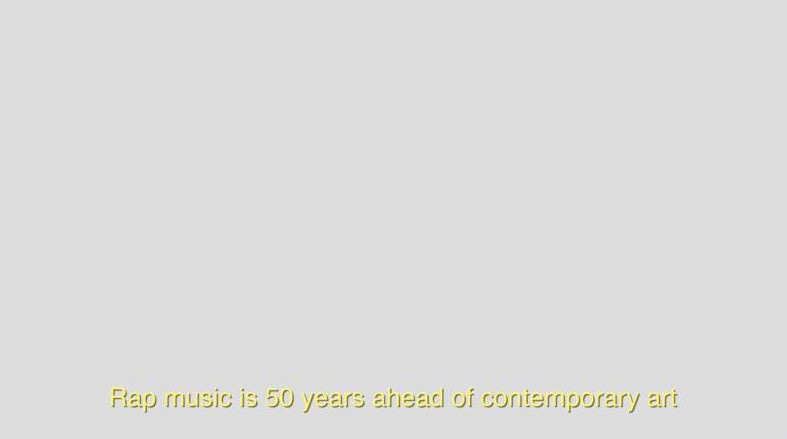

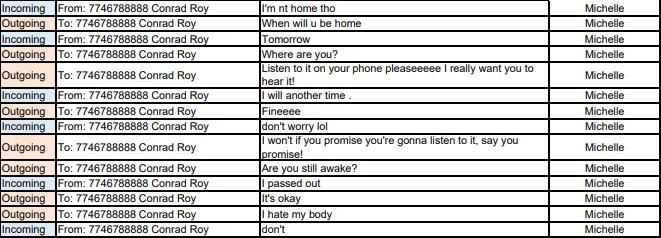
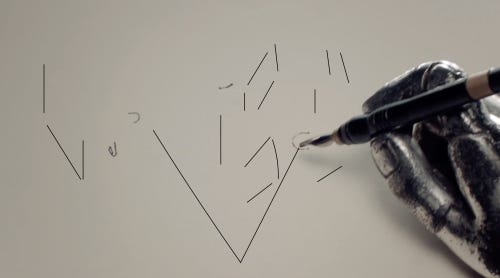


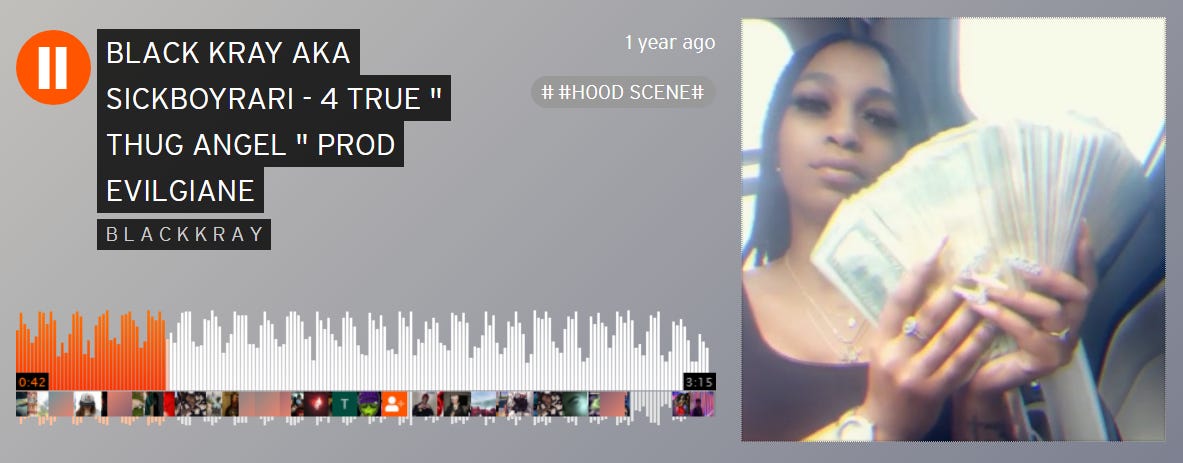
incredible and pithy work <3 lacan predicted hexd